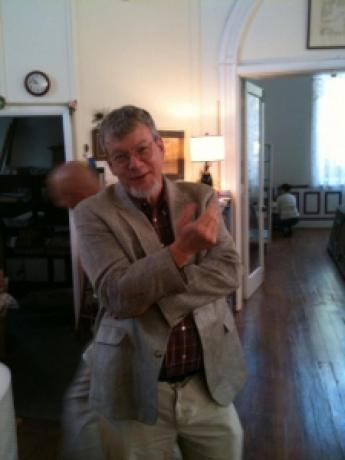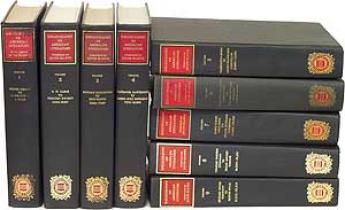Actualités
Joel Silver: Bibliography for Booksellers

By Ken Giese
In September the Mid-Atlantic Chapter of the ABAA sponsored a mini bookfair at The Bookshop in Old New Castle. The event featured Joel Silver, professor, librarian, and curator of books at the Lilly library at Indiana University, who presented a day-long seminar surveying reference resources relevant to the trade. Joel was the lure that attracted a large number of booksellers to Bob Fleck’s grand Opera House, a beautiful, historic building in the heart of New Castle. He satisfied all present with his lively take on a comprehensive body of resources. He also contributed to a successful bookfair the following day, where he was on hand to sign copies of his new book, Dr. Rosenbach and Mr. Lilly: Book Collecting in a Golden Age.
Reference information is indispensable to antiquarian booksellers. Like many traditional booksellers, here at BTC we have many hundreds of bibliographies and reference works that we can quickly consult to help us in identifying and verifying different books, editions, and autographs. But with more and more information available on the Internet, it may seem that there is no longer a need for booksellers to have a large reference library. Nothing could be further from the truth. There is still a great deal of information, necessary to properly cataloging a book, that can only be obtained from print sources.
The whole field of bibliographical reference is vast and no one person, or human brain, is capable of mastering it, but Joel has come close to committing most of it to memory (G. Thomas Tanselle should also be mentioned in this regard). Thus, as Joel went through his 244-page handout, it gave him great pleasure to inform us what the likely purchase price would be for each item listed in the handout, if it could be had for a bargain (at Oak Knoll, for example), or was accessible free on the web, &c. Also, as the list was long, in the fewest possible words he conveyed the salient points about the usefulness of each work under consideration, and its uniqueness, often with an occasional anecdote giving insight into the character or style of the author and/or compiler of the work.
Like Steve Jobs revealing a new generation of iPods, Joel brought us up to speed on the latest letter of the Gesamtkatalog der Wiegendrucke (GW), which, when completed, will be the most exhaustive catalog of 15th Century printed books. Published since 1925, the “first fascicle” of its eighth volume was completed in 1940. There are currently eleven volumes, detailing all incunabula through about the middle of the letter H, or “Hord, Jobst.”
Joel duly informed us of the first noble generation of incunabula compilers: Hain, Copinger, and Reichling. This was followed by a useful discussion of theBritish Museum Catalogue of Books Printed in the Fifteenth Century (BMC), and its arrangement in “Proctor Order” (i.e., Robert Proctor’s hierarchical classification scheme of incunabula by country, town, and print shop); along with an intriguing anecdote about Proctor’s death mountaineering while in the Alps. Goff’s Incunabula in American Libraries was not overlooked, nor was the currentIncunabula Short-Title Catalogue (ISTC).
For 16th Century books, H.M. Adams’ Catalogue of Books Printed on the Continent of Europe was praised by Joel for its collation statements and index of printers. Less well known is Contemporaries of Erasmus: A Biographical Register of the Renaissance and Reformation (edited by Bietenholz and Deutscher), which Joel recommended for its many biographies of Erasmus’s “less famous” friends (Erasmus, it seems, knew everybody).
And on we went throughout the day up to the present. Examples of important works for Americana less well-know to me include the Dictionary of Canadian Biography: “…especially useful for the Colonial period, and available for free online.”; and the Americana portion of E.D. Church’s library published under the title Catalogue of Books relating to the Discovery and Early History of North and South America, compiled and annotated by George Watson Cole (1907), which: “…provides an excellent overview of the subject, and it is a good read.”
On the subject of Americana, the Bibliography of American Literature (BAL) warrants the last word. Compiled by Jacob Blanck and completed by Michael Winship and Virginia L. Smyers (1955-1991), BAL provides extensive bibliographies of the literary works of 281 American writers from the Revolutionary period to 1930. Needless to say, Joel spent a little extra time discussing Mr. Lilly’s funding of this project and its principal personalities, namely Blanck and David Randall, the first Lilly Librarian and Professor of Bibliography.
Noted for the accuracy and extent of its publication details (the identification of first printed appearances in periodicals, variant editions, &c.), it also includes collation statements and other physical details on bindings and dustwrappers. For us at BTC, BAL is the Bible, our first go-to source. We’ll then consult separately published individual author bibliographies to supplement BAL as needed. BAL’s collation formulas and complementary signing statements for machine press books are especially useful for booksellers unwilling to damage an expensive modern first in order to determine how it was gathered! On this point, it’s worth noting that when BAL and an individual author’s bibliography give conflicting collational formula for an identical edition of a machine press book, Joel, (and David Whitesell, Curator of Books at the American Antiquarian Society), both say to go with BAL.
Finally, it was helpful to be referred to works important for their scholarship and style. In addition to classics like William A. Jackson’s The Carl H. Pforzheimer Library: English Literature 1475-1700 and Sir Walter Greg’s A Bibliography of the English Printed Drama to the Restoration, Joel also directed our attention to Falconer Madan’s Oxford Books: “…excellent annotations.”; David W. Forbes’Hawaiian National Bibliography: 1780-1900, and Sir Paul Harvey’s Oxford Companion to English Literature: “…later revised by Margaret Drabble, and though the revised edition has broader coverage, and the revisions were well done, Harvey’s own opinions which reveal his tastes and the flavor of the age are lost.” The same can be said about many other revised Oxford Companions.
Although we already have a very strong selection of literary references and bibliographies for use in our cataloging, there is always room for more. In addition, as our inventory branches out to include non-literary material, and books from before the 19th Century, there is a world of references of which we need to be aware. Now, with our 244-page handout from Joel in hand, we can avoid the temptation to cut and paste scattered bits of information from the web into our descriptions, but instead go to the definitive sources.
ILAB Breslauer Prize for Bibliography
>>> Learn more about one of the most prestiguous prizes!
Pictures: BTC catalogers Anne and Ashley excitedly discuss the new Gesamtkatalog der Wiegendrucke phone app. John Thompson, owner of Bartleby's Books and ABAA Vice President, bemused by the dearth of cat bibliographies ponders a new career. The article is published in The Between the Covers Blog. It is presented here by permission of the author.

